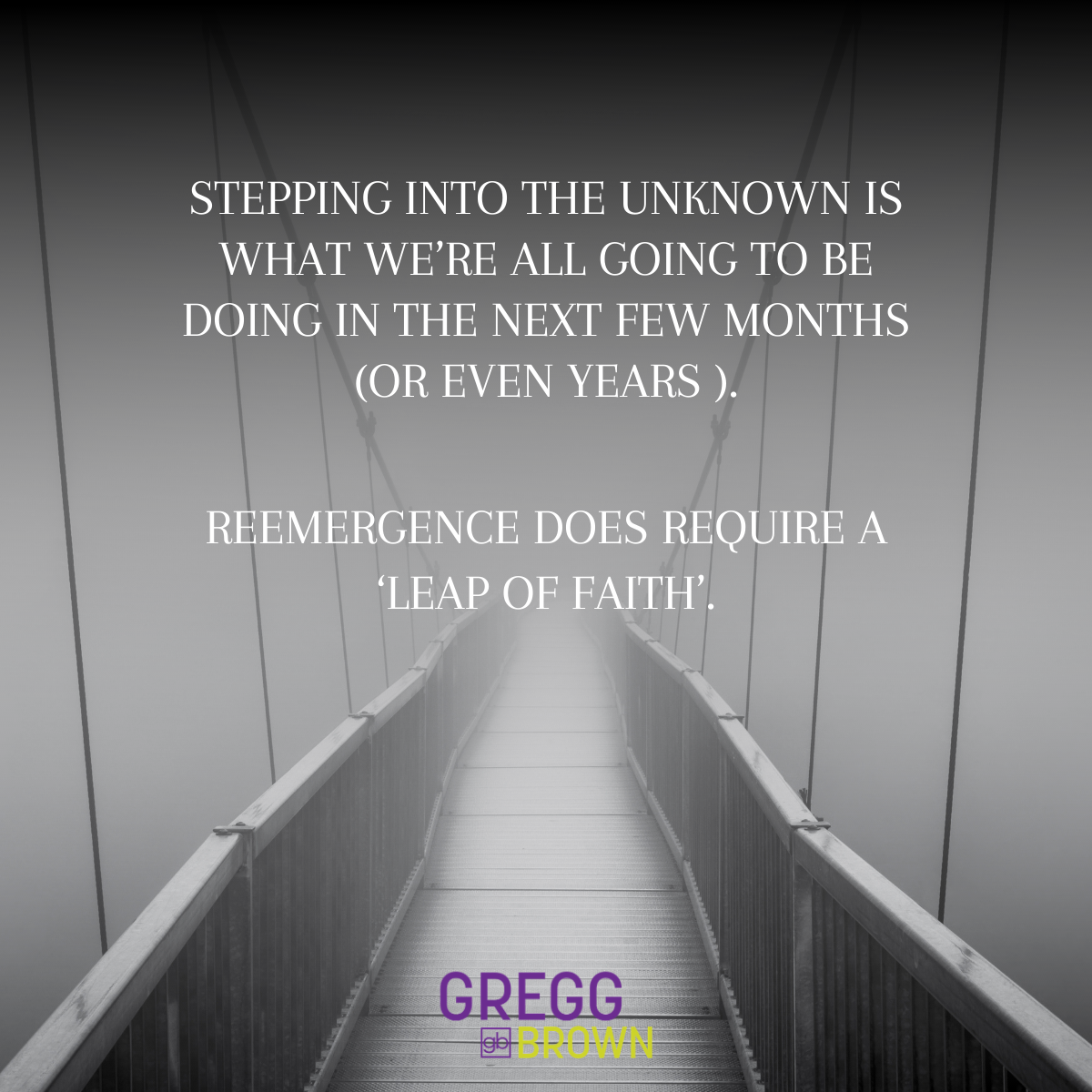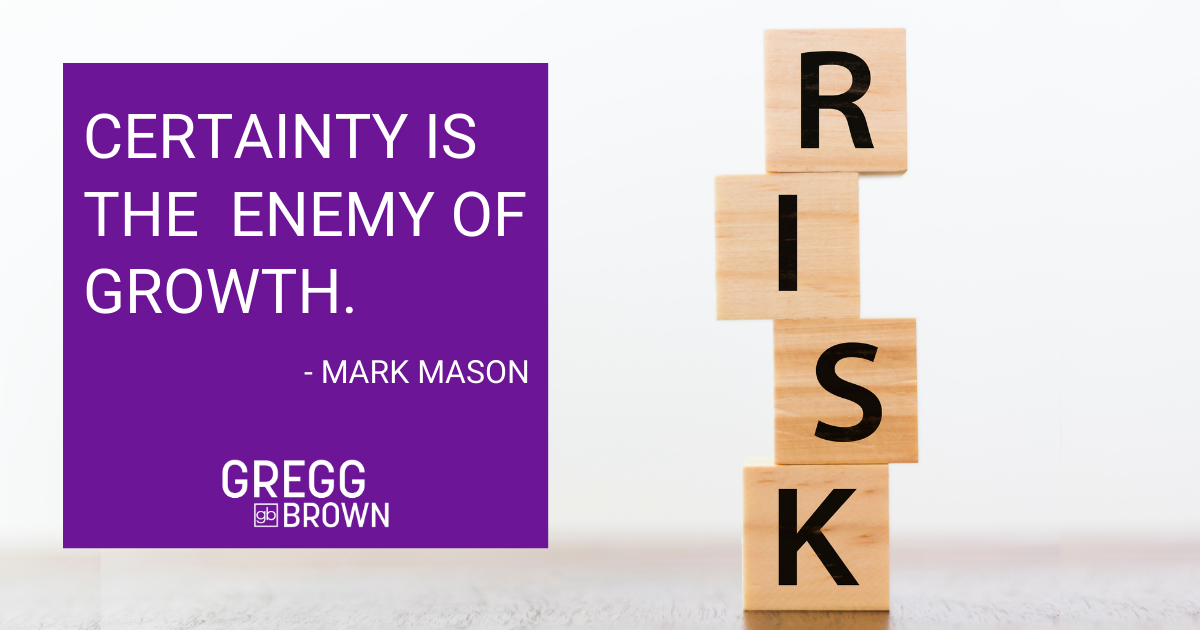In mid-March 2020, the comfort of ‘normal’ slipped away from us. Uncertainty became the norm, and we discovered that we are apprentices to change, not its masters. You’ve probably also learned that you’re more change ready than you think you are. Yet when you look to the future of work in your organization, fear and uncertainty are most likely hanging in the background. This is a crucial point in history—what you do now will either make or break your success.
Below is my MIA approach to help you rapidly respond to change. MIA isn’t the Miami airport code or missing in action. It is Mindset – Innovation – Action.
So how do you do that?
6 Steps to Shape the Future of Work in Your Organization
Do you remember the clip from Indiana Jones and the Last Crusade where he must cross a huge chasm with no apparent way to do so? Remembering the message about taking a ‘leap of faith,’ he takes a giant step, dangling his foot out into the open air and then stepping down. Instead of plummeting into the bit below, he ends up finding solid ground! Taking that risk – and moving step-by-step across the path – allowed him to reach the treasure on the other side.
Stepping into the unknown is what we’re all continuing to do. Check out these steps below to guide your way.
Change happens internally first. Then the external processes and skills happen. When we do it for ourselves (the internal work), then we can illuminate the path for others in our organization (the external work). Here are three internal and three external steps to get started.
MINDSET
The first two steps require you to mentally pivot and view the change situation in a new light.
1. Internal: Shift Your Mindset
Are you still thinking (or hoping) that things will go back to ‘normal’ in your business or organization? Shaping the future of work will require you to abandon those thoughts! I think there are going to be a bunch of ‘new normals’ that will keep shifting in the next few years, so it is important to not get your mind ‘set’ on any one path forward. (More on shifting your mindset can be found here.)
2. External: Analyze The Ecosystem

Analyzing your ecosystem is more than just an environmental scan of your external surroundings. It involves looking at your organization holistically – the people, the leaders, the personalities, the mindsets, the history, the processes, the technology…in sum, the entire context of the change. It is likely that current realities have shifted the ecosystem of your organization. Take a good look at the changes and contemplate how you may harness them to shape the future of work in your area of work.
What is the most important part of the ecosystem that you need to consider moving forward?
INNOVATION
Once you’ve shifted your mindset, you’re ready to expand your thinking and examine new ways of stepping into change.
3. Internal: Be Open to Ideas
Expanding your thinking means being open to systems, ideas, and processes that you may not have considered before. Making a major shift may sound like it will be time-consuming. However, an interesting lesson that Covid-19 has taught us is that you don’t necessarily need a lot of time to make big changes in your organization.
If the pandemic never happened and your organization was planning on going virtual, how long would that take? Maybe about two years? One year to plan, another year to implement in slow, careful stages. However, many of the clients I work with made the change to a mostly virtual organization in just three weeks! The ‘need’ to change due to coronavirus made the execution of change a priority, and these organizations have accomplished so much in so little time. Think about what else you could do if you had a driving force (motivation) to do it?

Group of happy young multiethnic business people wearing masks working at office table. Safe workplace after COVID-19. Diverse team cooperating at busy coworking with coronavirus precautions.
It does take practice to expand our thinking. Consider this quote from Alice in Wonderland:
“There’s no use trying,” Alice said. “One can’t believe impossible things.”
“I daresay you haven’t had much practice,” said the Queen. “When I was your age, I always did it for half-an-hour a day. Why sometimes I’ve believed as many as six impossible things before breakfast.”
The practice of expanding your thinking will allow you to break through old mental models; it will inspire innovation in how you think and act. What seems ‘impossible’ to you, that just might be possible?
4. External: Plan Diverse Approaches
In step 2, you analyzed your current ecosystem. Having that information—AND a mind that is open to possibilities and potential (steps 1 and 3)—you can now think about the many different paths that the future of work may take in your organization. Plans need to be nimble, agile, and able to be executed in a short time frame. As things move forward, be ready to change course at a moment’s notice. When you focus your energy on a specific purpose, you can adjust quickly to get the greatest results.

To focus on purpose, ask the right questions. The word ‘question’ comes from the word ‘quest’ which is the start of a journey. What journey do you want to start people on? The right questions can guide that journey. For example, if you simply ask, “What did you accomplish last week?” you will get a status update. In addition, if you ask, “Why was that important to you?” you go deeper by asking the person to focus on their purpose and priorities.
One of my favourite cities in the world to go to is Paris. If you look at their subway map, you’ll see that there are many different ways to get to the same place! In your organization, there could be many paths to get to your final destination. What could they be?
ACTION
A shifted mindset and expanded ideas will allow you to take action in the face of uncertainty—to do something different and better than before.
5. Internal: Take a Risk
When you are wanting to take action, you may get worried. What I’ve learned is worries are just made up negative stories. Now I’m not saying ‘Don’t listen to other people’s worries’. Absolutely listen. When you’re ready to take action, find evidence or proof of past successes. When we find proof, it removes doubt. And when we remove doubt, it gives us courage to step into the change.
You can also ground your worries in facts and look at them as risks.
(I’m not saying jump off the cliff without a parachute!) Living in the unknown creates possibility, and possibility gives you opportunities to innovate, create, and experience something new. What is exciting, (if there is some good out of these interesting times) is that all of us have a new set of skills, qualities, and practices we didn’t have at the start of the pandemic. What are your new skills or qualities, and how will you use them?
If you get stuck on this step of risk-taking, ask, “What is the likelihood of this risk I am worried about happening?” “What can I do to reduce the chance that it will happen?” And, “If it does happen, how does it impact what I’m trying to do? Is the impact low, medium, or high?”
You can’t manage all risks, but by focusing on the higher impact risks, you can mitigate or reduce some of them. The process will help you get unstuck and formulate a new plan to reach the desired goal.
You’ve come this far. You’re ready to take action. Let’s get to the last step.
6. External: Create the New
Shaping the future of work is about creating a new reality for yourself and your organization. It means more external ACTION! So, what is the new behaviour, skill, technology, or business process you want to create? Now is the time to do what Indiana Jones did and step into the new. To help you do this…
- Don’t do idea generation and decision making at the same time, as it won’t bring about new ideas. We’ve all been to those meetings where new ideas pop up but get shut down the next minute. Nothing gets accomplished. Then you have to have another meeting to figure out what happened at the last meeting! Who has time for that? During your meeting, be very clear on your agenda how much time is for idea generation, and how much time will be for determining which ideas we can take action on. Make sure there is a clear distinction between both. This gives all possibilities and suggestions a chance and most importantly, allows innovation to occur.
- As you go forward, balance emotional response with the facts. The unknown can create fear and cause us to say ‘no’ purely for emotional reasons. There are also valid emotional responses. Balance the emotional responses (don’t dismiss or discard them) with the facts. Is there any evidence or proof that other situations/people/organizations have done something similar?
- Watch what goes into your brain as you start your day. Don’t watch, listen, or read the news for the first hour—it will impact your mindset and your ability to make decisions throughout the day.
The future of work in your organization is going to be different than you probably imagined. Apply the MIA process – MINDSET – INNOVATION – ACTION. To start, incorporate one of the six steps listed above into your daily practices. it’s the magic of daily changes that will create the biggest difference in the quality of your life and the quality of your work. Who knows what great things you might create?




